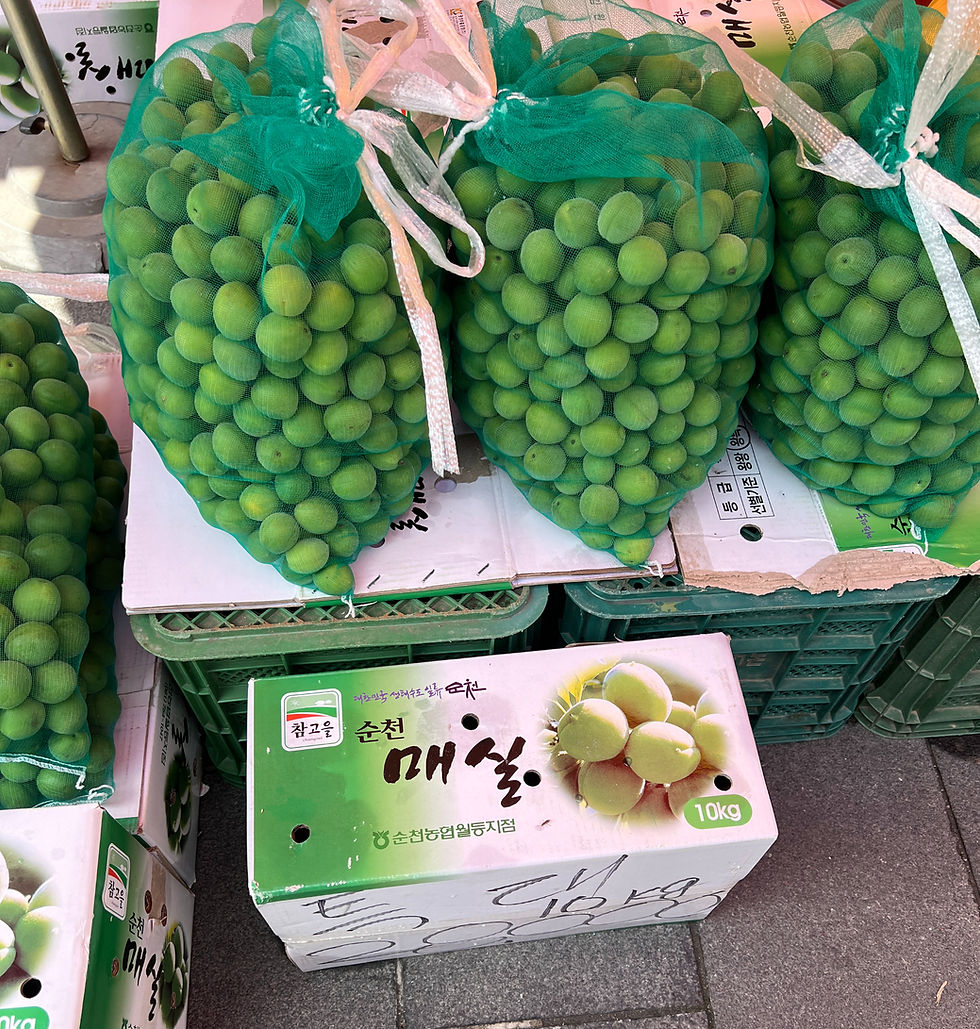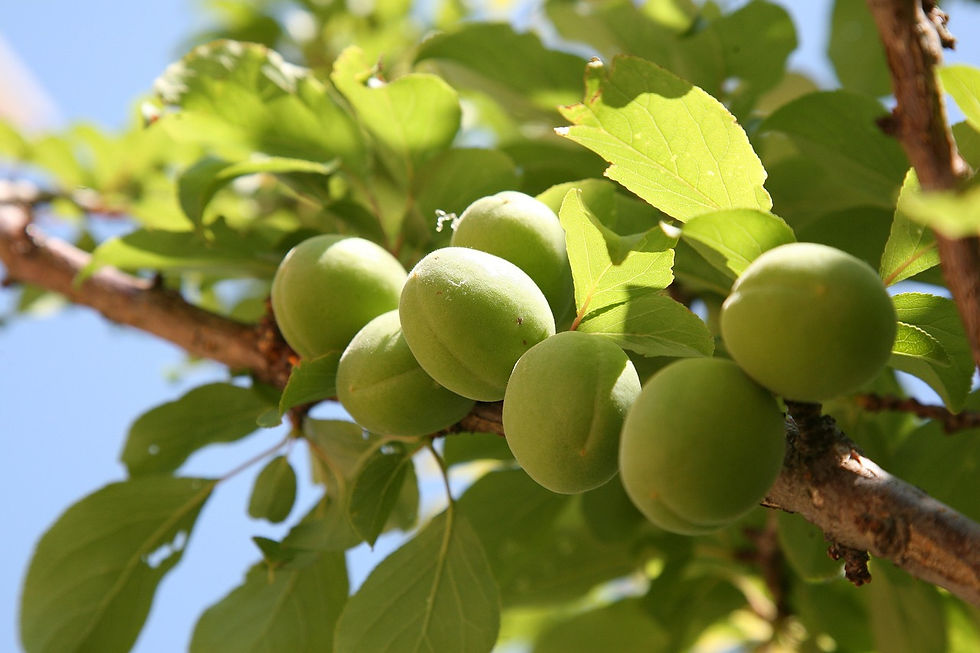Maesil-Cheong (매실청) Recipe: From Market to Mason Jar How to Make Plum Syrup at Home
- Melissa Edwards-Whittington

- Jul 3
- 7 min read
Updated: Jul 30

When my husband, Chuck, and I first began exploring Korean cooking, we never expected one humble ingredient to capture our hearts and taste buds. That star ingredient? Maesil-cheong (매실청), also known as maesilaek (매실액)—a sweet, tangy syrup made from green plums (maesil, 매실), also called ume in Japan. We noticed it popping up repeatedly in recipes as a secret flavor booster, adding just the right touch of brightness and balance to everything from marinades to dipping sauces.
As we experimented with Korean recipes, we kept seeing maesil-cheong pop up as a secret ingredient—brightening flavors, balancing savory sauces, and adding just the right touch of sweetness. Our curiosity deepened as we dove into videos and blogs by beloved chefs like Maangchi, Korean Bapsang, KimchiMari, Chef Julie Yoon, and especially Chef Seonkyoung Longest, whose vibrant cooking style first introduced us to the magic of this golden syrup. So when we spotted crates of green plums at the 3/8 market last summer, inspiration struck—and we decided to try making it ourselves.
In Korea, maesil-cheong 매실청 isn’t just something you keep in the back of the pantry—it’s a meaningful part of everyday life and tradition. Rooted in a culture that values seasonal ingredients, fermentation, and the idea that food should nourish both body and soul, this plum syrup is used not just for its bright flavor but also for its many health benefits. A little tangy, a little sweet, and full of goodness, maesil-cheong has earned its place in many Korean households, whether it’s steeped into a soothing tea or used to add depth and complexity to everyday dishes.

What is Maesil 매실 in Maesil-Cheong?
Maesil 매실 refers to the green, unripe Japanese apricot—commonly called a green plum in English—that grows abundantly in Korea. These plums are usually harvested in late spring or early summer, when they are still firm and tart. In traditional Korean medicine, it is valued for aiding digestion, detoxifying the body, and boosting energy. However, because of their sour and bitter taste, these tart green fruits are rarely eaten raw. Instead, they are preserved, fermented, or turned into syrups and liqueurs.
June marks the peak of maesil (green plum) season in Korea, when markets and roadside stands are overflowing with these tart, aromatic fruits. It’s the perfect time for households across the country to start making maesil-cheong (매실청), as the freshly harvested plums are ideal for fermenting into syrup or turning into seasonal preserves. That sweet Korean plum syrup is like liquid gold.
Ingredients & Tools for Homemade Maesil-Cheong
To make maesil-cheong at home, you’ll need:
Fresh green plums (maesil) – 1 kg
White sugar – 1 kg (equal weight to plums)
Sterilized glass jar or fermenting container
Optional: Fermentation weight, knife, chopsticks

To be honest, we hadn’t planned on making maesil-cheong (매실청) at all. But during a summer stroll through the 3/8 market, we spotted crates of fresh green plums and got inspired. The gears started turning: what if we made our own maesil-cheong 매실청… and then used it to craft a homemade maesil 매실 brandy? As home distillers who love experimenting with small-batch whiskeys and fruit brandies, the idea was too tempting to resist.
So, without watching a single tutorial, we enthusiastically bought 20 kilograms of plums on the spot. Naturally, that meant 20 kilograms of sugar and a massive fermentation jar to match. In the end, this would yield about three gallons of Korean plum syrup or liquid gold—more than enough to share with friends and fuel dreams of our first batch of homemade plum brandy.
Once we recovered from our spontaneous plum-buying spree, we dove into researching the proper way to make maesil-cheong (매실청) at home. The process was a bit more involved than we expected, but getting hands-on with this time-honored Korean tradition was an experience we absolutely loved.
Step-by-Step Maesil-Cheong Recipe

Here is the process to create your own amazing maesil-cheong:
Clean the Plums Rinse the plums thoroughly under cold water. Remove stems and any damaged or bruised fruit. Dry the plums completely with a towel—excess moisture can lead to mold.
Cut or Prick the Plums You can leave the plums whole, prick them with a fork, or slice them in half. Cutting them speeds up fermentation but may slightly alter the flavor.
Layer with Sugar In your sterilized jar, alternate layers of plums and sugar until everything is used. Start your layers with sugar and make sure the top layer is sugar to help prevent mold.
Seal and Store Close the lid tightly and store the jar in a cool, dark place. You can gently stir or shake the jar every few days to mix the sugar and fruit.
Stir For the first few weeks, give the plums and sugar a gentle stir every couple of days to help the sugar dissolve evenly. If you notice the plums at the top starting to discolor or see any white film forming, give it a stir—this helps keep everything well-mixed and fermentation on track.
Ferment Let the mixture sit for at least 3 months, though many people wait 6 months or more. Over time, the sugar will draw out the juice, creating a thick syrup.
Strain and Bottle Once fermentation is complete, strain out the fruit. Pour the syrup into clean bottles and store it in the refrigerator or a cool pantry.
See It in Action: Making Maesil-Cheong at Home with KimchiRednecks
Want to see how our maesil-cheong journey unfolded step by step? We documented the whole process on our YouTube channel, KimchiRednecks! From selecting fresh maesil at the market to layering jars of sugar and plums, our video walks you through how we made this sweet syrup at home, plus a few surprises along the way.
If you’re a visual learner or just want a closer look at how simple (and fun!) it can be to make maesil-cheong yourself, this video is a great companion to the recipe above.
How to Use Maesil-Cheong in Drinks and Cooking
Maesil-cheong is both a flavorful ingredient and a traditional remedy. Here are a few common uses:
In Beverages: Mix a tablespoon with hot or cold water for a refreshing tea (maesil-cha 매실차). Add to sparkling water or cider for a fizzy drink.
In Cooking: Use in marinades for beef, pork, or fish to tenderize and sweeten naturally.
As a Dressing: Add maesil-cheong to soy sauce, vinegar, and sesame oil for a quick salad dressing or dipping sauce.
In Cocktails/Mocktails: Use in place of simple syrup for a fruity, tangy twist.
As a Home Remedy: Traditionally, it is used to relieve indigestion, fatigue, or a sore throat.
Tips & Warnings When Making Homemade Maesil-Cheong
Cleanliness is key. Always use sterilized jars and utensils to avoid spoilage.
Use only firm, unripe plums. Ripe yellow maesil can cause the syrup to spoil or ferment improperly.
Avoid eating the leftover plums raw — their seeds contain amygdalin, which can release toxins if not properly processed.
Label your jar with the start date so you’ll know when it’s ready to bottle.
Health Benefits of Maesil-Cheong (매실청)
Beyond its sweet, tangy flavor, maesil-cheong is treasured in Korean households for its natural health benefits. Traditionally, it’s been used to:
Aid Digestion: A spoonful mixed with water or tea can help ease bloating and support a healthy gut.
Boost Energy: Its natural acids are believed to help reduce fatigue and refresh the body after a long day.
Soothe Discomfort: Often enjoyed as a warm tea to calm an upset stomach or mild sore throat.
Support Overall Wellness: Packed with vitamins and antioxidants, it’s a simple way to add a nourishing boost to drinks, marinades, and everyday meals.
Whether you sip it as a tea, mix it into sparkling water, or use it in cooking, maesil-cheong offers a little extra goodness with every drop.
Bottle Up a Taste of Korean Sunshine
Making maesil-cheong (매실청) is an excellent way to connect with Korean tradition while crafting something that's both delicious and healing. Whether you're looking to support your gut health, add a splash of flavor to your favorite dishes, or sip on a cozy, homemade tea, this sweet-tart syrup delivers. Try making a batch this summer—you might find yourself bottling up a little sunshine to carry you through the rest of the year.
Not quite ready to make your own? No worries, maesil-cheong is easy to find at Korean grocery stores and traditional markets.
FAQs About Maesil-Cheong (매실청)
What is maesil-cheong made from?
Maesil-cheong is made from unripe green plums (maesil, 매실) and sugar. The mixture is fermented over several months to create a sweet, tangy syrup traditionally used in Korean cuisine and natural remedies.
How long does maesil-cheong need to ferment?
For best flavor and results, ferment maesil-cheong for at least 3 months. Many people let it sit for 6 months or longer to develop a deeper, more complex flavor.
Can I use ripe yellow plums instead of green plums?
No, it’s important to use firm, unripe green plums. Ripe or yellowing plums can cause improper fermentation or spoil the syrup.
What does maesil-cheong taste like?
Maesil-cheong has a sweet and tangy flavor with a subtle floral note. It’s often described as refreshing, bright, and slightly fruity—perfect for balancing savory dishes or sweetening drinks.
How do you use maesil-cheong in cooking?
It’s incredibly versatile! Use maesil-cheong in:
Marinades for meats and fish
Dipping sauces and salad dressings
Tea (maesil-cha, 매실차)
Cocktails or mocktails as a natural sweetener
Even as a home remedy for sore throats and indigestion
Can I eat the plums after making maesil-cheong?
It’s best not to eat the leftover plums raw, as their seeds contain amygdalin, which can release toxins. You can, however, boil or cook them into jam after removing the pits.
How should I store maesil-cheong once it’s done fermenting?
After straining, store maesil-cheong in a clean glass bottle in a cool, dark place or the refrigerator. Properly stored, it can last for over a year.
Explore More About Maesil-Cheong
Want to dive deeper into the world of maesil-cheong and Korean plum syrup traditions? Here are some great external resources to check out:
These articles offer additional insights, recipes, and cultural background on maesil and its many uses in Korean cuisine.
More Recipes from Melissa & KimchiRednecks
If you enjoyed this homemade maesil-cheong recipe, check out more of our kitchen favorites:
From savory soups to sweet seasonal bakes, our kitchen adventures are always full of flavor and a touch of fun. Come cook with us and make sure to check out our YouTube channel for more recipes!












3 Comments